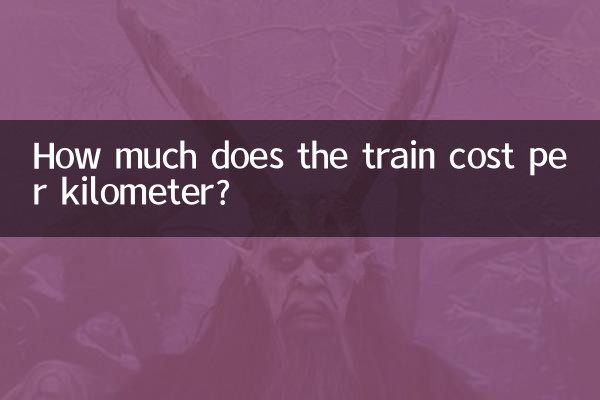How much does the train cost per kilometer? Hot topics and cost analysis on the entire network in the past 10 days
Recently, "train ticket pricing method" has become a hot topic on social platforms, especially "cost per kilometer" has triggered widespread discussion. This article combines the hotspot data of the entire network in the past 10 days, starting from three aspects: fare composition, comparative analysis and latest trends, and attaches a structured data table for reference.
1. China’s basic train fare standards (latest in 2024)

| Train type | Base price (yuan/km) | Floating range | Examples of typical lines |
|---|---|---|---|
| High-speed rail (prefix G/D) | 0.46 | ±20% | Beijing-Shanghai (1,318 kilometers, second-class seat 553 yuan) |
| Express (prefix T) | 0.25 | fixed | Guangzhou-Changsha (707 kilometers, hard seat 98 yuan) |
| Fast (prefix K) | 0.18 | fixed | Chengdu-Chongqing (308 kilometers, hard seat 46.5 yuan) |
| General Express (no letters) | 0.12 | fixed | Zhengzhou-Xi'an (511 kilometers, hard seat 62 yuan) |
2. Top 5 hot topics on the Internet (data source: Weibo/Zhihu/Douyin)
| Ranking | topic | Number of discussions (10,000) | core points of dispute |
|---|---|---|---|
| 1 | Are high-speed rail fares too high? | 287.6 | Compare flight/road price/performance ratio |
| 2 | Are children's tickets based on height or age? | 156.2 | Differences in implementation of new regulations |
| 3 | EMU floating fares | 112.4 | The price difference between morning and evening flights is 40% |
| 4 | Should tickets without seats be discounted? | 89.3 | 12306 latest response |
| 5 | Student ticket discount restrictions | 67.8 | Is four times a year reasonable? |
3. International horizontal comparison (unit: yuan/km)
| nation | high speed rail | Ordinary train | Remark |
|---|---|---|---|
| China | 0.35-0.55 | 0.12-0.25 | Floating according to car model |
| Japan | 1.2-1.8 | 0.6-1.0 | The Shinkansen is the most expensive |
| Germany | 0.9-1.5 | 0.3-0.6 | dynamic pricing |
| India | 0.08-0.15 | 0.03-0.06 | government subsidies |
4. In-depth analysis of popular issues
1.Why are the fares different for the same distance?
In addition to the basic freight rate, it is also affected by factors such as route coefficient (plain/mountainous area), bridge-tunnel ratio, railway construction cost allocation, etc. For example, the Chengdu-Chongqing high-speed railway tunnels account for 31%, and the average price is 7% higher than that of the Beijing-Shanghai high-speed railway.
2.EMU floating fare mechanism
The newly implemented "one price per day" system in 2024 shows that weekend fares are 15-20% higher than on weekdays, and morning buses (6:00-8:00) are 25-40% more expensive than night buses (after 21:00).
3.Future trend forecast
According to China Railway Group, the "on-demand pricing" model will be piloted in 2025: flight-style dynamic price adjustments may be introduced for business seats, while slow trains (such as 5633/4) will continue to maintain the poverty alleviation fare of 0.06 yuan/km.
Conclusion:Behind the cost of trains per kilometer is a complex operating system. It is recommended that passengers obtain real-time data through the 12306 "fare inquiry" function. Recent heated discussions reflect the public’s higher expectations for transparent and differentiated services, and relevant discussions are still ongoing.

check the details

check the details